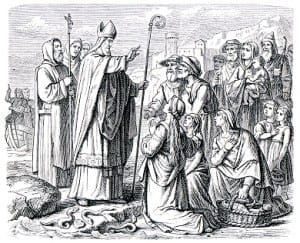 March 17, known around the world as St. Patrick’s Day, is a national holiday celebrated in Ireland with great joy, and Americans join in as well. It is traditional for Irish Americans and others to commemorate the occasion by the “wearing of the green,” putting on clothing in the national color of Ireland, often in the form of a three-leaf clover.
March 17, known around the world as St. Patrick’s Day, is a national holiday celebrated in Ireland with great joy, and Americans join in as well. It is traditional for Irish Americans and others to commemorate the occasion by the “wearing of the green,” putting on clothing in the national color of Ireland, often in the form of a three-leaf clover.
Catholics in Ireland and other countries regard St. Patrick’s Day as a day of holy obligation, that is, a day to worship through rest, just as one would rest on Sabbath. In Ireland, the day is a celebration of pride, heritage and faith, complete with fireworks, parades and other festive events all over the country.
St. Patrick himself is still regarded highly in the Catholic, Greek Orthodox, Lutheran and Anglican traditions. Like St. Nicholas, who is associated with Christmas, and St. Valentine, associated with February 14, Patrick is underappreciated by comparison with the holiday supposedly in his remembrance. Who is this saint?
Captured by pirates
The ecclesiastic text “St. Patrick’s Confession” describes the early life and conversion experience of this church leader, who was born with the name Maewyn Succat. According to this document, Maewyn’s father, Calpurnius, was a deacon, one of the sons of Potitus, an elder presiding over the church in Banavem Taverniae. While on his father’s farm in Britain, Maewyn was kidnapped by Irish pirates and sold to a sheep rancher.
He worked faithfully as a slave for six years, learning the Irish dialect and growing in seeking God. During this time he came to faith in Jesus as the Messiah. After his conversion, he traveled two hundred miles to find a port where he could escape to England. The crew first refused to take him aboard. Then, sensing his frustration, the sailors changed their minds, permitting him to board the ship and prove he was a friend any way he could.
Rescued through prayer
After docking in a friendly harbor, the ship’s crew began to run out of food. Patrick reports in his confession that the captain said to him, “What about this, Christian? You tell us that your God is great and all-powerful — why can’t you pray for us, since we’re in a bad state with hunger? There’s no sign of us finding a human being anywhere!”
Patrick replied, “Turn in faith with all your hearts to the Lord my God, because nothing is impossible for him, so that he may put food in your way — even enough to make you fully satisfied! He has an abundance everywhere.”
Shortly after this prayer, the crew found a herd of pigs and also some honey where they had landed, and they feasted and gave thanks to God. They attempted to share the honey with Patrick, but one of them stated that the honey had been offered in sacrifice to another god, and so Patrick would have none of it. Yet God provided food for them all until they finally found a town to dwell in.
Commissioned supernaturally
Patrick made his way back to England, began studying theology and returned to his parents. They pled with him, “Do not leave again.” However, at home he received a vision: an Irishman appeared to be reading letters from Ireland, pleading for him to return. After he had finished his studies, he was permitted to go.
The Irish were making idols of God’s creations, rather than worshipping God himself. The legend is possible, though not confirmed, that Patrick used the shamrock, one clover with three leaves, to explain the Trinity to the Irish (this is unrelated to the adoption of the rare four-leaf clover as a symbol of superstition much later). Patrick’s writings do confirm that understanding the Creator caused many to dedicate their lives completely to Christ, some even by vows of celibacy.
Persevering in God
Patrick endured many trials in Ireland. He faced both honest questions and accusations about his motives for returning there. Some claimed he accepted gifts from wealthy converts. His answer was:
“I have tried to keep a guard on myself and for the Christians and virgins of Christ and religious women who were giving me small gifts of their own accord. When they would throw some of their ornaments on the altar, I would give them back to them. They were hurt at me that I would do this.” He also offered to return any alleged undue gifts, and more, if charges made against him were proven true.
When Patrick traveled, he ensured that his fellow travelers were paid for their service. One time, kings who had proclaimed friendship with him took Patrick and his sailing companions as prisoners and stole their belongings. However, under conviction about their promises to Patrick and about the wrath of God, these kings later returned the property and freed Patrick and his crew, who successfully returned to Ireland.
St. Patrick consistently gave God the glory for his work in Ireland. He firmly believed he was called by God to work among the Irish and would be held guilty if the work were not finished. He longed for the Lord to guide him to conclude his work and return to England someday, to visit his family and native land. The Spirit never released him to return during his lifetime. He lived and died among the Irish, whom God had called him to love and to train in the good news of Jesus Christ.
Penni Bulten is a homeschooling mom who is fascinated with the Founding Fathers and their faith. She can be reached at [email protected].

Comments